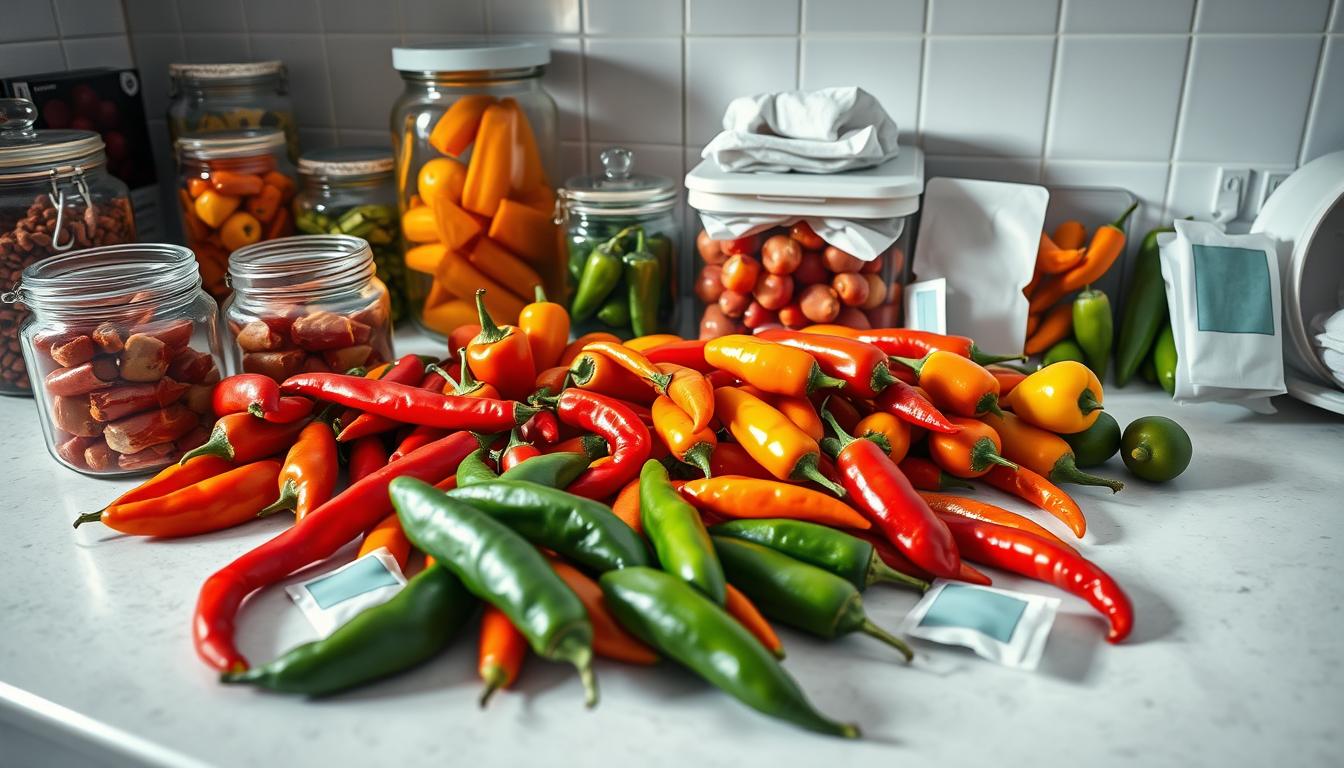Are you ready for a taste adventure that makes meals unforgettable? Hot peppers are more than ingredients. They’re flavor powerhouses that can change your cooking!
Step into the spicy world of chili peppers. Each pepper has its own story of heat, complexity, and culture. From the mild jalapeño to the fiery Trinidad 7Pot Yellow Brainstrain, these peppers can elevate any dish.

Imagine a world where each hot pepper adds its own unique flavor to your food. Whether you love spicy food or are just curious, this journey will spark your love for bold flavors.
Key Takeaways
- Discover the incredible diversity of hot peppers
- Learn how pepper heat can transform your cooking
- Explore global culinary traditions centered around chili peppers
- Understand the science behind spicy sensations
- Master techniques for handling and preparing hot peppers
Understanding the World of Hot Peppers
Explore the world of hot peppers, where flavors burst and traditions shine. There are over 400 pepper varieties, each with its own heat and uses. These peppers will make your taste buds dance.
Exploring Pepper Varieties
Hot peppers are more than spicy – they’re a global treasure. They range from mild bell peppers to the fiery Pepper X. Let’s look at some interesting varieties:
- Poblano: Mild and earthy (1,000-2,000 SHU)
- Jalapeño: Medium heat (2,500-5,000 SHU)
- Habanero: Intense heat (100,000-350,000 SHU)
- Carolina Reaper: Extreme heat (1,500,000-2,200,000 SHU)
- Pepper X: World’s hottest (2,693,000 SHU)
The Science of Pepper Heat
Capsaicin is what makes peppers spicy. The Scoville Scale measures this heat, from 0 SHU for bell peppers to 16 million SHU for pure capsaicin. Capsaicin also protects pepper plants from pests.
Cultural Culinary Significance
Hot peppers are key in global cooking, adding unique flavors. They’re used in Mexican salsas and Thai curries. Hot peppers tell stories of culture and culinary creativity. They offer a thrilling journey in the kitchen.
Exploring the Scoville Scale: From Mild to Wild
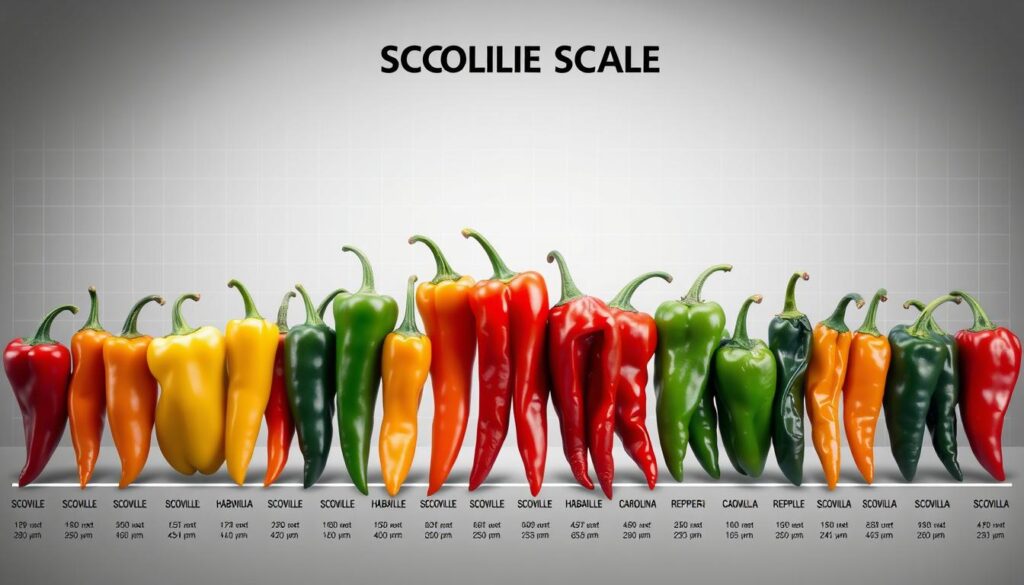
Ever wondered how spicy peppers are measured? The Scoville scale is your ultimate guide to understanding pepper heat. It helps you explore the world of chili peppers, from the mildest bell peppers to the fire-breathing Carolina Reaper.
The Scoville Heat Unit (SHU) provides a scientific way to rate the intensity of chili peppers. Let’s break down some interesting heat levels:
- Bell peppers: 0 SHU (no heat at all)
- Jalapeño peppers: 2,500 to 8,000 SHU
- Cayenne peppers: 35,000 to 50,000 SHU
- Habanero peppers: 100,000 to 350,000 SHU
- Carolina Reaper: Up to 2.2 million SHU
Understanding the Scoville scale helps you choose peppers that match your heat tolerance. Pro tip: If you’re new to spicy foods, start with milder chili peppers and work your way up. Remember that pepper heat can vary based on growing conditions and individual pepper characteristics.
Interestingly, capsaicin – the chemical responsible for pepper heat – is what creates that burning sensation. The more capsaicin, the higher the SHU rating. Dairy products like milk can help neutralize the heat if you accidentally bite into a pepper that’s too spicy for your palate.
Whether you’re a heat seeker or prefer a gentle kick, the Scoville scale is your roadmap to exploring the exciting world of chili peppers!
The Rise of Aji Amarillo: Peru’s Golden Treasure
Discover the culinary sensation that’s transforming kitchens worldwide – the Aji Amarillo pepper. This golden hot pepper from Peru has captured the hearts of chefs and food enthusiasts. It’s known for its unique flavor and incredible versatility.
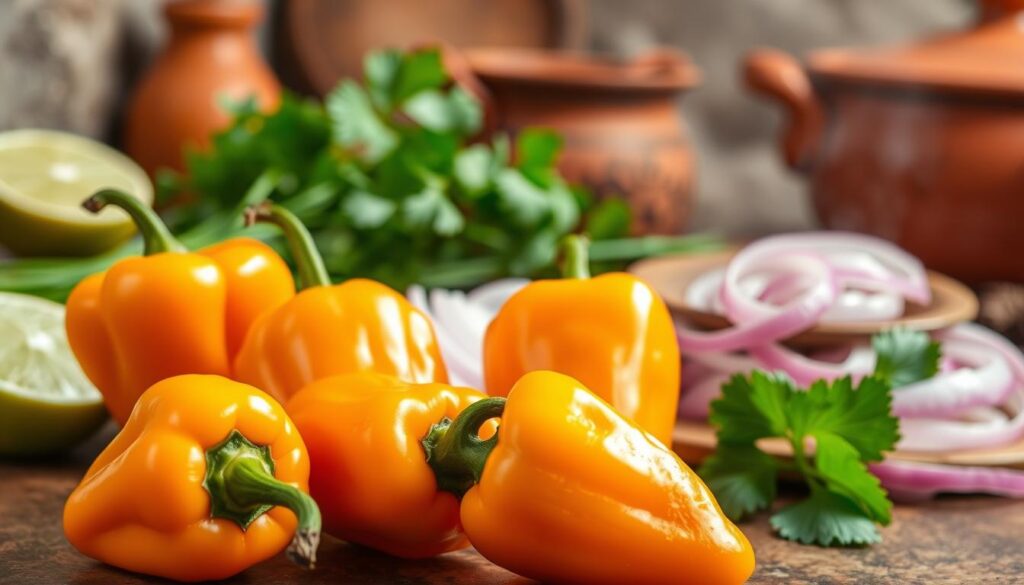
Unique Flavor Profile and Heat Level
Aji Amarillo stands out among pepper varieties. It has a Scoville rating between 30,000 to 50,000 heat units. This pepper delivers a medium-intensity warmth that tantalizes the taste buds.
Its flavor is a complex blend of fruity and tropical notes. This sets it apart from other chili peppers.
- Scoville Heat Range: 30,000-50,000 units
- Flavor Profile: Fruity and tropical
- Color: Bright golden-yellow
Culinary Applications and Growing Popularity
Your culinary adventures will reach new heights with Aji Amarillo’s incredible versatility. Peruvian cuisine relies on this pepper for approximately 50% of its flavor profile. It’s a cornerstone of traditional dishes like Aji de Gallina and ceviche.
- Key ingredient in Huancaina sauce
- Essential for traditional Peruvian recipes
- Growing popularity in fusion cuisine
McCormick’s 2025 Flavor Forecast
The future looks bright for Aji Amarillo. The global chili pepper market is expected to grow by 6.5% between 2023 and 2028. This pepper is set to become a global culinary star.
Peru exports around 10,000 tons annually. Consumer awareness has increased by 15% in the last year.
Experience the golden treasure that’s revolutionizing global cuisine!
Hot Pepper Health Benefits and Nutritional Value
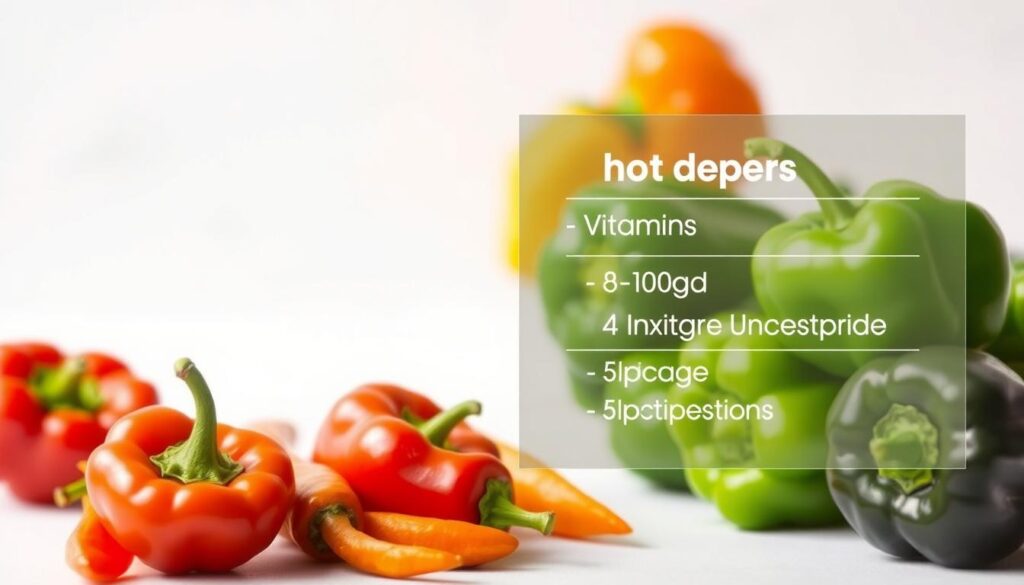
Hot peppers are more than just a flavor boost. They are a nutritional powerhouse with amazing health benefits. The secret is capsaicin, the compound that gives them that fiery taste.
Pepper health benefits are vast and exciting. Research shows they can:
- Boost metabolism and help with weight management
- Reduce body inflammation
- Potentially lower heart disease risk
- Boost immune function with vitamins
Hot peppers are full of nutrients. They have three times more vitamin C than oranges! A half-cup of green chili peppers has few calories but lots of minerals and vitamins.
Capsaicin in hot peppers is truly amazing. Studies show it may:
- Reduce arthritis and fibromyalgia pain by up to 50%
- Potentially slow cancer cell growth in several cancers
- Help control hunger through sensory neuron activation
- Improve metabolic health
While hot peppers are great, eat them in moderation. Experts say to limit them to half a cup or less to avoid stomach problems. Your body will appreciate the spicy nutritional boost!
Mastering Hot Pepper Cultivation
Growing your own hot peppers can make gardening exciting. It’s great for both experienced gardeners and newbies. Pepper cultivation is a fun journey into growing spicy food at home.
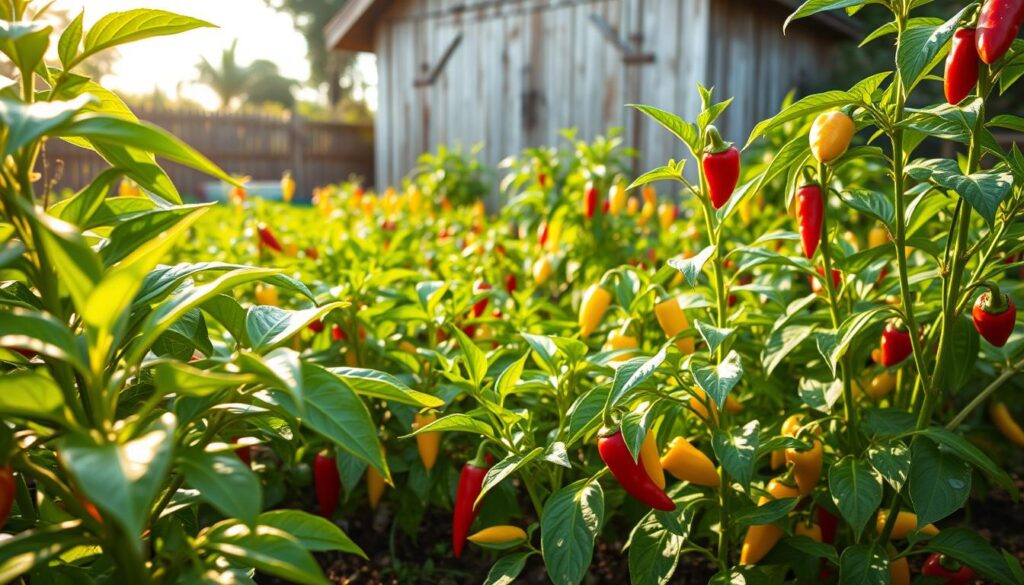
To start your hot pepper journey, learn what they need to grow well. Each type of pepper has its own special needs to grow big and strong.
Essential Growing Conditions
Hot pepper plants need careful care to grow well. Here are the main things to keep in mind:
- Sunlight: Aim for 6-8 hours of direct sunlight daily
- Temperature: Keep it between 65-85 degrees Fahrenheit
- Soil: Use well-draining, nutrient-rich soil with pH between 6.0-6.8
- Water: Keep it moist but not too wet
Navigating Cultivation Challenges
Hot pepper plants face many challenges. But, with the right steps, you can avoid most problems:
- Watch for pests with yellow sticky traps
- Use neem oil to fight whiteflies
- Choose disease-resistant varieties
- Rotate crops to avoid soil diseases
Harvesting and Storage Insights
Harvesting your hot peppers at the right time is key. Each type ripens differently:
- Jalapenos: 70 days green, 90 days red
- Habaneros: About 90-100 days
- Cayenne peppers: Around 75 days when red
“The secret to great hot peppers is patience and attentive care.” – Pepper Cultivation Expert
By following these tips, you’ll be ready to grow tasty hot peppers in your garden or on your balcony.
Scotch Bonnet: Caribbean Heat Sensation
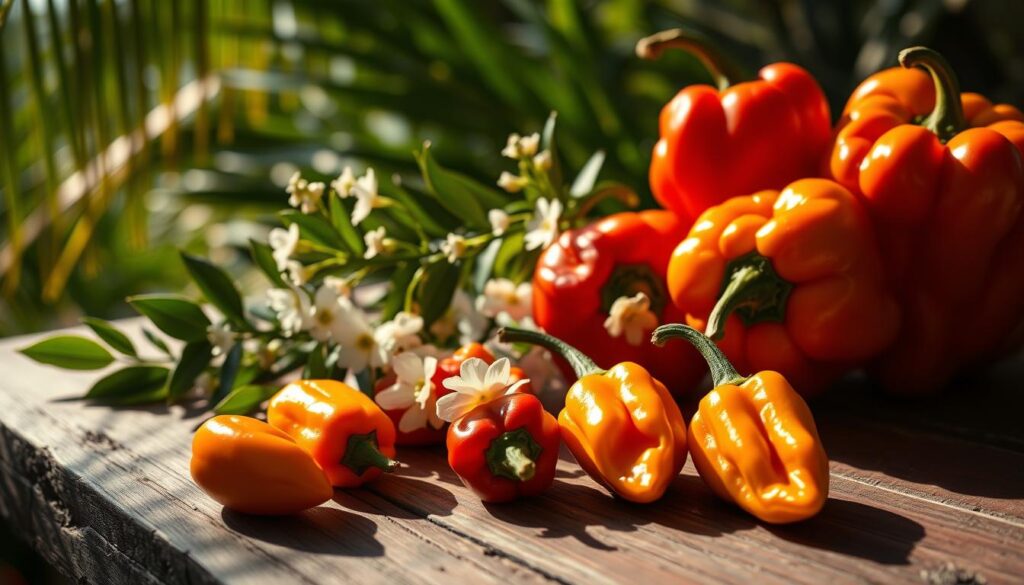
Ready to dive into the fiery world of Scotch Bonnet peppers? These small peppers are a true culinary gem. They bring explosive Caribbean flavor to your kitchen. With a heat level of 100,000 to 350,000 Scoville Heat Units (SHU), they are 12 to 14 times hotter than jalapeños.
Scotch Bonnet peppers come in exciting variants. Each offers unique characteristics:
- Scotch Bonnet Chocolate (Brown): Slightly hotter standard variety
- Scotch Bonnet Yellow (Mustard): Sweeter with milder heat
- Tobago Scotch Bonnets: Elongated shape with classic heat profile
Using these peppers can transform traditional dishes. Jerk chicken and hot sauces get a big boost from their fruity heat. Chefs pair them with mango, pineapple, and tomatoes to balance the intense heat.
“A little Scotch Bonnet goes a long way in creating authentic Caribbean flavor!” – Caribbean Cooking Experts
When working with these peppers, safety is key. Always use kitchen gloves and consider goggles to avoid chili burn. Whether you’re a spice lover or new to pepper culinary uses, Scotch Bonnets offer an unforgettable taste experience. They’ll take you straight to the Caribbean.
Creative Culinary Applications and Recipes
Discover the magic of chili peppers in your kitchen. They turn simple meals into unforgettable dishes. Home cooks and chefs love experimenting with pepper recipes, exploring new flavors and heat levels.
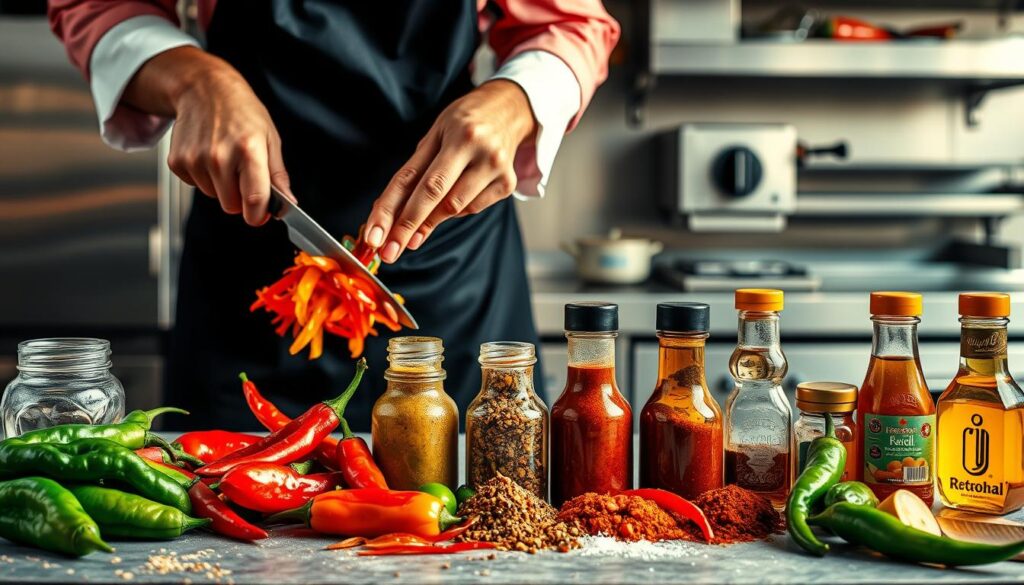
Spicy Rubs and Marinades
Take your grilling to the next level with spicy rubs and marinades. Use different chili peppers to create unique spice blends. This adds intense flavor to meats and veggies.
- Jalapeño-based dry rubs for robust meat dishes
- Serrano pepper marinades for chicken and fish
- Smoky chipotle seasoning blends
Hot Sauce Crafting
Learn to make your own hot sauce. It can be mild or very spicy, depending on the peppers. This is a fun way to capture the unique flavors of chili peppers.
| Pepper Type | Scoville Heat Units | Flavor Profile |
|---|---|---|
| Jalapeño | 2,500 – 8,000 | Fresh, grassy heat |
| Serrano | 10,000 – 23,000 | Sharp, bright heat |
| Cayenne | 30,000 – 50,000 | Intense, burning heat |
Tropical Heat Fusion Dishes
Mix tropical flavors with spicy peppers for amazing dishes. Try mango-habanero salsas or pineapple-jalapeño glazes. They mix sweet and spicy for a thrilling taste journey.
“Cooking with peppers is an art form that transforms simple ingredients into extraordinary meals.” – Chef Maria Rodriguez
Handling and Storing Hot Peppers Safely
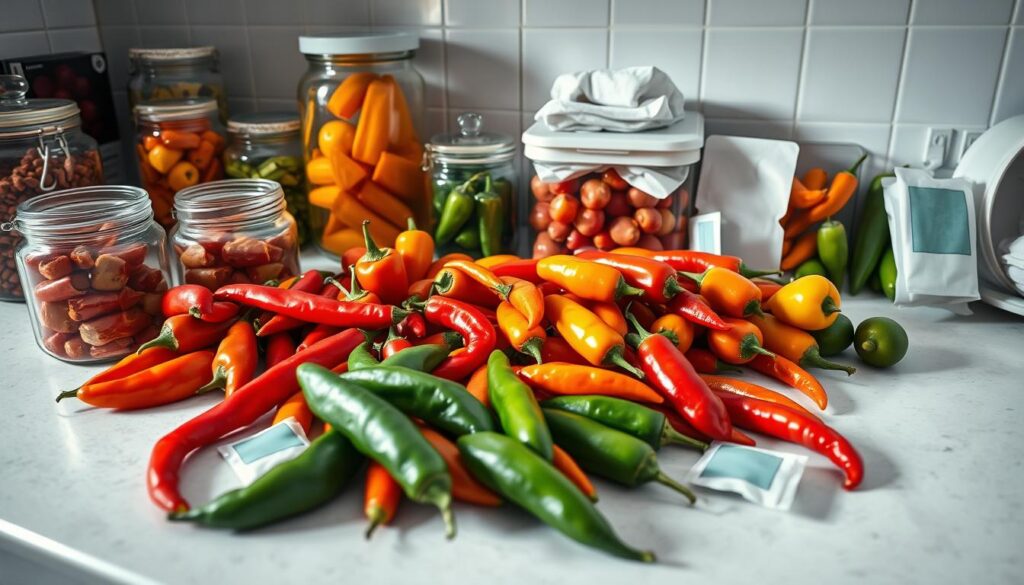
Working with hot peppers requires safety first. These peppers are very hot and can hurt if not handled right. It’s important to protect yourself while cooking and storing to enjoy your meal.
First, get the right gear. Always wear gloves when you handle hot peppers, especially the hottest ones. The oils from these peppers can really irritate your skin and cause burning.
- Use disposable latex or nitrile gloves
- Avoid touching your face or eyes during pepper preparation
- Wash hands thoroughly after handling hot peppers
How you store hot peppers depends on their type and how you plan to use them. Fresh peppers need special care to stay good and last longer.
- Refrigerate whole peppers at 40°F to 45°F
- Whole peppers can last 10 to 14 days when properly stored
- Cut peppers have a shorter shelf life of 4 to 5 days
To keep peppers for a long time, dry them. Dried hot peppers can last up to a year if stored right. Use a food dehydrator at 68°-80°F. It usually takes 2 to 12 hours, depending on the pepper size.
Pro tip: Keep a small stem attached to peppers to help prevent wrinkling and extend freshness!
Store dried chiles in glass jars, filling them about two-thirds full to keep air flowing. Vacuum sealing is also a great way to keep flavor and quality.
Conclusion
Your journey into the world of hot peppers is exciting. It’s full of flavor and health benefits. Studies show that chili peppers are more than spicy. They’re a culinary adventure.
Research says eating hot peppers often can lower health risks. It also makes meals more exciting. Hot peppers are not just for adding heat.
They add depth and variety to your cooking. Whether you love spice or are just curious, hot peppers can change your cooking. They make every dish more interesting.
As you explore chili peppers, remember each one is special. You can now try new things and enjoy these amazing ingredients. Let hot peppers add excitement and depth to your cooking.
FAQ
What is the Scoville Scale, and how does it measure pepper heat?
The Scoville Scale measures the capsaicin in peppers, showing their heat level. It ranges from 0 (bell peppers) to over 2 million Scoville Heat Units (SHU) for the hottest peppers like the Carolina Reaper. The higher the number, the more intense the burning sensation you’ll experience when eating the pepper.
Are hot peppers good for my health?
Yes! Hot peppers are good for you. Capsaicin, the compound that makes them hot, may boost metabolism and reduce inflammation. They’re also full of vitamins A and C, which can help your heart and aid in weight management. But, eat them in moderation.
How can I safely handle hot peppers in my kitchen?
Always wear disposable gloves when handling hot peppers, especially the hottest ones. Avoid touching your face or eyes during preparation. Wash your hands thoroughly with soap after handling, and clean cutting boards and utensils with a bleach solution. If you accidentally get capsaicin on your skin, use milk or yogurt to neutralize the burning sensation.
What are some beginner-friendly hot peppers to start with?
If you’re new to spicy foods, start with milder peppers like jalapeños, poblanos, or banana peppers. These have a lower heat level on the Scoville Scale and can help you build tolerance. As you become more comfortable, you can gradually move to moderately spicy peppers like serranos or cayenne peppers.
Can I grow hot peppers at home?
Absolutely! Hot peppers can be grown in gardens or even on balconies. They require full sun, well-draining soil, and consistent watering. Most pepper plants do well in containers and can be grown from seeds or seedlings. Choose a variety that matches your climate and available space, and follow specific care instructions for each pepper type.
What’s a good way to use hot peppers in cooking?
Hot peppers are incredibly versatile! You can use them in marinades, rubs, sauces, salsas, and as a fresh ingredient in various dishes. Try creating homemade hot sauces, adding them to stir-fries, or using them to spice up grilled meats and vegetables. Each pepper variety brings a unique flavor profile to your cooking.
Table of Contents
How do I reduce the heat of a hot pepper?
To reduce a pepper’s heat, remove the seeds and inner membranes, which contain the highest concentration of capsaicin. For extremely hot peppers, you can also blanch them in boiling water or soak them in milk or yogurt to neutralize some of the heat. Pairing spicy peppers with dairy or sweet ingredients can also help balance the intensity.

